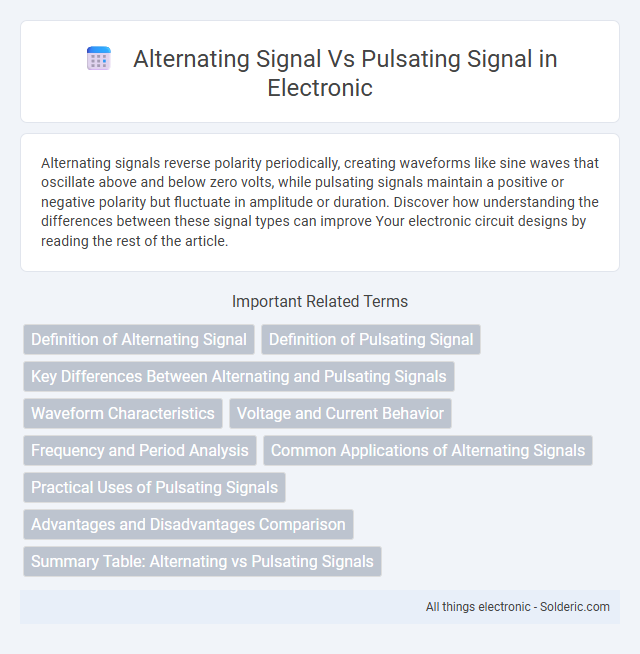Alternating signals reverse polarity periodically, creating waveforms like sine waves that oscillate above and below zero volts, while pulsating signals maintain a positive or negative polarity but fluctuate in amplitude or duration. Discover how understanding the differences between these signal types can improve Your electronic circuit designs by reading the rest of the article.
Comparison Table
| Feature | Alternating Signal | Pulsating Signal |
|---|---|---|
| Definition | Signal that periodically reverses direction or polarity. | Signal consisting of pulses with varying amplitude and duration, usually non-alternating polarity. |
| Waveform | Sinusoidal or periodic oscillations alternating above and below zero. | Rectangular or irregular pulses, often unidirectional. |
| Frequency | Continuous steady frequency with positive and negative cycles. | Pulse repetition rate varies; may not be continuous frequency. |
| Polarity | Alternates between positive and negative. | Typically positive only, or unidirectional pulses. |
| Applications | AC power supply, audio signals, radio waves. | Pulse modulation, digital signals, radar pulses. |
| Energy | Energy continuously delivered in both directions. | Energy delivered in bursts/pulses. |
| Example | Household AC voltage at 50/60 Hz. | Pulsed laser signals, digital heartbeat signals. |
Definition of Alternating Signal
An alternating signal is an electrical current or voltage that periodically reverses direction and varies in magnitude over time, typically represented by sine waves in AC power systems. Unlike pulsating signals that only change amplitude without reversing polarity, alternating signals continuously oscillate above and below a zero reference point. This characteristic enables the efficient transmission and distribution of electrical energy across power grids.
Definition of Pulsating Signal
A pulsating signal is an electrical waveform characterized by periodic bursts of energy that vary in amplitude but do not reverse polarity, resulting in unidirectional pulses. Unlike alternating signals that continuously change polarity in a sinusoidal manner, pulsating signals maintain a single polarity while fluctuating between zero and a peak value. This type of signal is commonly used in applications requiring controlled on-off switching or modulation without the complexity of polarity alternation.
Key Differences Between Alternating and Pulsating Signals
Alternating signals continuously change polarity and amplitude in a smooth, periodic manner, typically represented by sine waves, while pulsating signals consist of unidirectional pulses with varying amplitude, often generated by rectifying an alternating signal. You will notice alternating signals have both positive and negative cycles, whereas pulsating signals only contain positive cycles that fluctuate in magnitude. The key difference lies in the waveform shape and polarity behavior, impacting applications like AC power transmission for alternating signals versus DC power supply smoothing with pulsating signals.
Waveform Characteristics
Alternating signals exhibit smooth, continuous waveforms that regularly reverse polarity, typically forming sinusoidal shapes with consistent frequency and amplitude. Pulsating signals, in contrast, consist of unidirectional pulses with abrupt transitions between high and low states, creating a waveform that does not cross the zero axis. Understanding these waveform characteristics helps you accurately identify and utilize each signal type in electronic circuits and communication systems.
Voltage and Current Behavior
Alternating signals exhibit continuous voltage and current oscillations, reversing polarity and direction cyclically, typically described by sinusoidal waveforms. Pulsating signals maintain a unidirectional voltage and current that fluctuate in magnitude but do not change sign, often characterized by sharp rises and falls corresponding to pulse intervals. The voltage in alternating signals crosses zero periodically, creating zero-crossing points, whereas pulsating signals remain above zero or at baseline, reflecting their constant polarity.
Frequency and Period Analysis
Alternating signals have a continuous periodic waveform characterized by a constant frequency and period, typically represented as a sine wave oscillating above and below zero voltage. Pulsating signals consist of repetitive pulses with distinct on and off intervals, where the frequency is determined by the pulse repetition rate and the period equals the sum of pulse duration and pulse interval. Frequency and period analysis of alternating signals relies on smooth waveform cycles, while pulsating signals require measuring discrete pulse durations and intervals to calculate frequency accurately.
Common Applications of Alternating Signals
Alternating signals are widely used in power distribution systems, where alternating current (AC) efficiently transmits electricity over long distances with minimal loss. These signals are also essential in audio and radio frequency transmissions, enabling clear sound reproduction and wireless communication. Your electronic devices rely on alternating signals for proper operation, from household appliances to industrial machinery.
Practical Uses of Pulsating Signals
Pulsating signals are widely used in practical applications such as pulse width modulation (PWM) for motor control, where precise timing and power regulation are essential. They enable effective communication in digital systems by representing binary data with clear on-off states. In medical devices, pulsating signals facilitate accurate measurements and diagnostics, especially in devices like pulse oximeters and cardiac monitors.
Advantages and Disadvantages Comparison
Alternating signals provide continuous waveform oscillations with smooth transitions between positive and negative values, enabling efficient power transmission and reduced energy loss in AC electrical systems. Pulsating signals consist of unidirectional pulses that can simplify signal processing and are useful in digital electronics but often result in higher harmonic distortion and less efficient power delivery. Alternating signals are typically favored in power distribution for their steady energy flow, while pulsating signals excel in applications requiring discrete signal points despite increased electromagnetic interference.
Summary Table: Alternating vs Pulsating Signals
Alternating signals continuously vary in magnitude and polarity, typically represented by sinusoidal waveforms ideal for AC power systems. Pulsating signals, however, maintain a single polarity with varying magnitude, often seen in DC power applications with rectified waveforms. Your choice between these signals depends on whether constant polarity or alternating polarity best suits your electronic device or system requirements.
alternating signal vs pulsating signal Infographic

 solderic.com
solderic.com